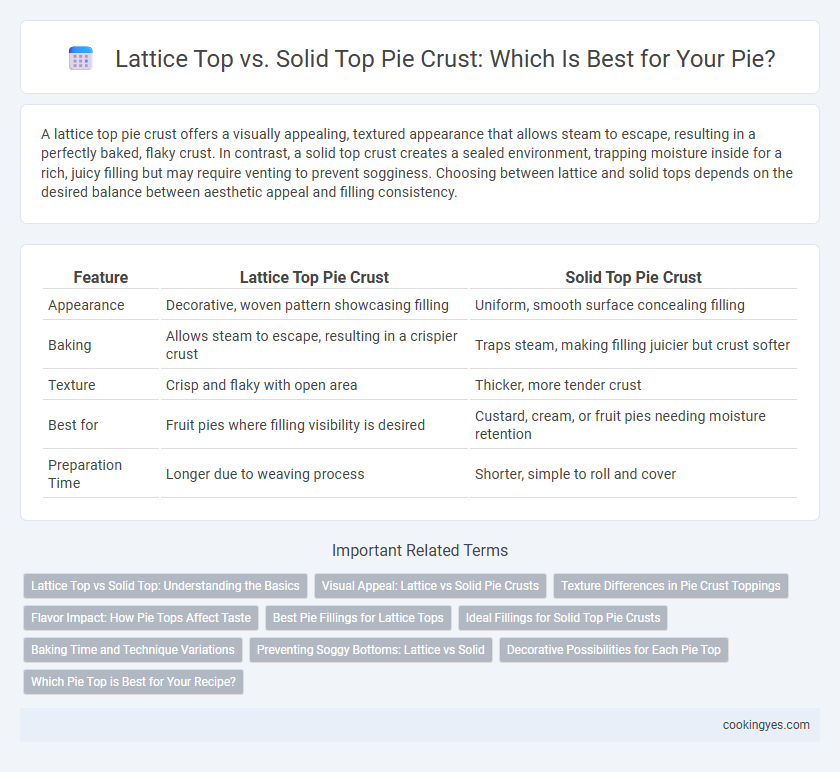A lattice top pie crust offers a visually appealing, textured appearance that allows steam to escape, resulting in a perfectly baked, flaky crust. In contrast, a solid top crust creates a sealed environment, trapping moisture inside for a rich, juicy filling but may require venting to prevent sogginess. Choosing between lattice and solid tops depends on the desired balance between aesthetic appeal and filling consistency.
Table of Comparison
| Feature | Lattice Top Pie Crust | Solid Top Pie Crust |
|---|---|---|
| Appearance | Decorative, woven pattern showcasing filling | Uniform, smooth surface concealing filling |
| Baking | Allows steam to escape, resulting in a crispier crust | Traps steam, making filling juicier but crust softer |
| Texture | Crisp and flaky with open area | Thicker, more tender crust |
| Best for | Fruit pies where filling visibility is desired | Custard, cream, or fruit pies needing moisture retention |
| Preparation Time | Longer due to weaving process | Shorter, simple to roll and cover |
Lattice Top vs Solid Top: Understanding the Basics
Lattice top pie crusts showcase an interwoven pattern of dough strips, allowing steam to escape and creating a visually appealing, textured surface that enhances fruit pies by adding crispness to the topping. Solid top crusts fully cover the pie filling, providing a thick, flaky barrier that locks in moisture and intensifies the flavors, making them ideal for custard or cream pies. Choosing between lattice and solid tops depends on the desired texture, visual appeal, and type of filling.
Visual Appeal: Lattice vs Solid Pie Crusts
Lattice pie crusts create an intricate, woven pattern that showcases the fruit filling beneath, enhancing the pie's visual appeal with texture and color contrast. Solid top crusts offer a smooth, uniform surface that can be decorated with cut-out designs or brushed with egg wash for a glossy, golden finish. Choosing between lattice and solid tops depends on the desired aesthetic impact--lattice tops highlight the filling and create a rustic look, while solid tops provide a classic, elegant presentation.
Texture Differences in Pie Crust Toppings
Lattice top pie crusts provide a crisp, flaky texture with exposed edges that bake evenly and develop a light crunch, ideal for fruit pies where steam escapes through the gaps. Solid top crusts create a thicker, tender, and more cohesive texture that retains moisture and offers a softer bite with a golden, flaky surface. The choice impacts not only texture but also moisture control and visual appeal, influencing the overall pie experience.
Flavor Impact: How Pie Tops Affect Taste
Lattice top pie crusts enhance flavor by allowing steam to escape, which concentrates the filling's natural sweetness and fruitiness, creating a more vibrant taste experience. Solid top crusts provide a buttery, flaky texture that complements the filling while sealing in juices, resulting in a richer, more indulgent flavor profile. The choice between lattice and solid top crust can significantly influence the balance of crust-to-filling flavor in traditional fruit pies.
Best Pie Fillings for Lattice Tops
Lattice top pie crusts are ideal for fruit fillings like apple, cherry, and blueberry, as the open weave allows steam to escape and juices to thicken evenly. The gaps in the lattice create a visually appealing pattern that highlights colorful, vibrant fruit layers beneath. Best suited for sweet pies with thick or slightly runny fillings, lattice tops prevent sogginess and promote a crisp, golden finish.
Ideal Fillings for Solid Top Pie Crusts
Solid top pie crusts excel with moist, juicy fillings such as apple, cherry, and blueberry, as the full coverage prevents leakage and locks in flavors during baking. Dense fruit mixtures and custards benefit from the protective barrier of a solid crust, ensuring even cooking and a tender, flaky finish. This type of crust effectively retains moisture, making it ideal for sweeter, saucier fillings prone to bubbling over.
Baking Time and Technique Variations
Lattice top pie crusts require shorter baking times because their open design allows steam to escape, preventing soggy fillings and promoting even crust browning. In contrast, solid top crusts often need longer baking to ensure the filling cooks thoroughly and the crust becomes fully golden without burning. Techniques like venting in solid tops and careful egg-washing in lattice tops are critical to achieving the perfect balance of texture and appearance during baking.
Preventing Soggy Bottoms: Lattice vs Solid
A lattice top pie crust allows steam to escape during baking, reducing moisture buildup and preventing a soggy bottom crust. Solid top crusts trap steam beneath them, which can increase sogginess if not vented properly. For fruit pies with juicy fillings, lattice tops enhance airflow and create a crisper bottom compared to solid tops.
Decorative Possibilities for Each Pie Top
Lattice tops offer intricate, woven patterns that create visually appealing designs while allowing steam to escape, enhancing the pie's texture and flavor. Solid tops provide a smooth, consistent surface, ideal for decorative cuts, stencils, or brushed egg wash to achieve a glossy finish and elegant look. Both top styles enable unique, artistic expressions, with lattice shells showcasing craftsmanship and solid tops offering a canvas for creative embellishments.
Which Pie Top is Best for Your Recipe?
Lattice top pie crusts provide excellent ventilation, allowing steam to escape and preventing a soggy filling, making them ideal for fruit pies like apple or cherry where a crisp, golden finish is desired. Solid top crusts offer a sealed environment that locks in moisture, preserving the juiciness of custard or pumpkin pies, and contribute to a rich, flaky texture. Choosing between lattice and solid tops ultimately depends on the pie's filling consistency and how much steam release the recipe requires for perfect baking.
Lattice top vs Solid top for pie crust Infographic

 cookingyes.com
cookingyes.com